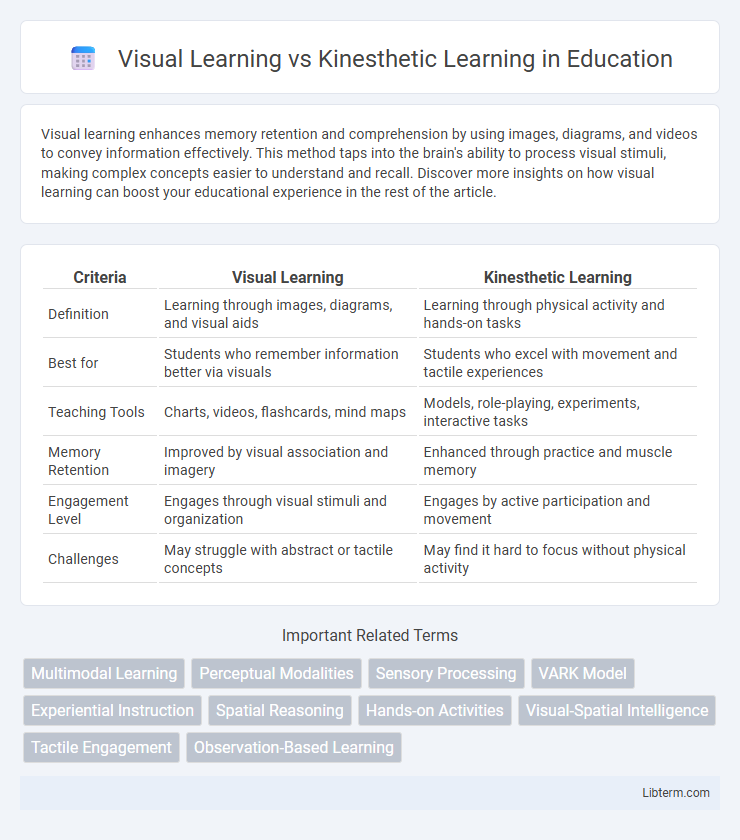Visual learning enhances memory retention and comprehension by using images, diagrams, and videos to convey information effectively. This method taps into the brain's ability to process visual stimuli, making complex concepts easier to understand and recall. Discover more insights on how visual learning can boost your educational experience in the rest of the article.
Table of Comparison
| Criteria | Visual Learning | Kinesthetic Learning |
|---|---|---|
| Definition | Learning through images, diagrams, and visual aids | Learning through physical activity and hands-on tasks |
| Best for | Students who remember information better via visuals | Students who excel with movement and tactile experiences |
| Teaching Tools | Charts, videos, flashcards, mind maps | Models, role-playing, experiments, interactive tasks |
| Memory Retention | Improved by visual association and imagery | Enhanced through practice and muscle memory |
| Engagement Level | Engages through visual stimuli and organization | Engages by active participation and movement |
| Challenges | May struggle with abstract or tactile concepts | May find it hard to focus without physical activity |
Introduction to Learning Styles
Visual learning emphasizes processing information through images, diagrams, and spatial understanding, making it easier to recall visual cues. Kinesthetic learning relies on physical activity and hands-on experiences to internalize concepts, engaging muscle memory for retention. Recognizing these distinct learning styles enhances personalized education strategies and improves knowledge absorption.
What is Visual Learning?
Visual learning is a cognitive process where individuals absorb and retain information best through images, diagrams, charts, and spatial understanding. This learning style relies heavily on visual stimuli to enhance memory and comprehension by transforming information into visual formats. Visual learners benefit from tools such as graphs, videos, and written notes that allow them to interpret and analyze content visually.
Key Characteristics of Visual Learners
Visual learners process information most effectively through images, diagrams, and spatial understanding. They rely heavily on color-coding, charts, and written instructions to enhance memory retention and comprehension. These learners excel when using visual aids such as maps, videos, and graphic organizers to organize and recall information.
What is Kinesthetic Learning?
Kinesthetic learning is a style of learning where individuals grasp information best through hands-on activities and physical movement. This type of learner benefits from engaging in tasks such as building models, participating in experiments, or role-playing to understand concepts deeply. Kinesthetic learning contrasts with visual learning by emphasizing tactile experiences over visual input for effective knowledge retention.
Key Characteristics of Kinesthetic Learners
Kinesthetic learners absorb information best through hands-on activities, physical movement, and tactile experiences, relying heavily on muscle memory to retain knowledge. They often prefer learning environments that incorporate experiments, role-playing, and real-life simulations to engage their bodily senses. This learning style emphasizes active participation, spatial awareness, and coordination, distinguishing kinesthetic learners from visual ones who primarily process information through images, diagrams, and written text.
Visual vs Kinesthetic Learning: Core Differences
Visual learning relies on spatial understanding and imagery, enabling learners to process information through diagrams, charts, and written directions. Kinesthetic learning emphasizes physical activity and hands-on experiences, helping individuals absorb concepts by doing and engaging in movement. The core difference lies in how sensory input is prioritized: visual learners benefit from seeing and visualizing, while kinesthetic learners thrive through tactile interaction and muscle memory.
Advantages of Visual Learning
Visual learning enhances memory retention by leveraging images, diagrams, and spatial understanding to help learners process and recall information more effectively. This mode of learning supports quick absorption of complex concepts through visual aids such as charts, graphs, and videos, making abstract ideas more concrete. Visual learners benefit from improved comprehension and engagement, especially in subjects like science, geography, and art where visualization is critical.
Benefits of Kinesthetic Learning
Kinesthetic learning enhances memory retention by engaging the body in physical activities, which helps create stronger neural connections. This hands-on approach promotes active problem-solving and improves motor skills, making it ideal for subjects requiring practical application, such as science experiments or technical tasks. Kinesthetic learning also increases engagement and motivation, especially for learners who struggle with traditional, sedentary methods.
Strategies for Supporting Visual and Kinesthetic Learners
Visual learners benefit from instructional strategies that incorporate diagrams, charts, and color-coded notes, enhancing memory retention through spatial organization and imagery. Kinesthetic learners thrive with hands-on activities, movement-based tasks, and opportunities for role-playing, which engage their tactile and physical learning modalities. Tailoring study environments by integrating technology like interactive whiteboards for visual learners and manipulatives or physical models for kinesthetic learners significantly boosts educational outcomes.
Choosing the Right Learning Style for Success
Choosing the right learning style, whether visual learning or kinesthetic learning, significantly enhances academic performance and skill acquisition. Visual learners excel by processing information through images, diagrams, and spatial understanding, while kinesthetic learners benefit from hands-on activities and physical engagement that reinforce memory and comprehension. Tailoring study techniques to these learning preferences helps optimize retention, motivation, and overall success in both educational and professional settings.
Visual Learning Infographic

 libterm.com
libterm.com